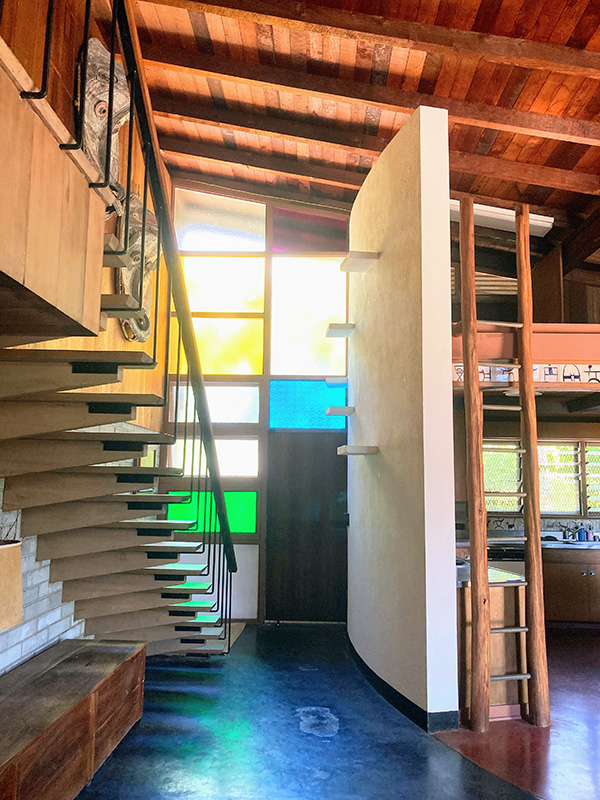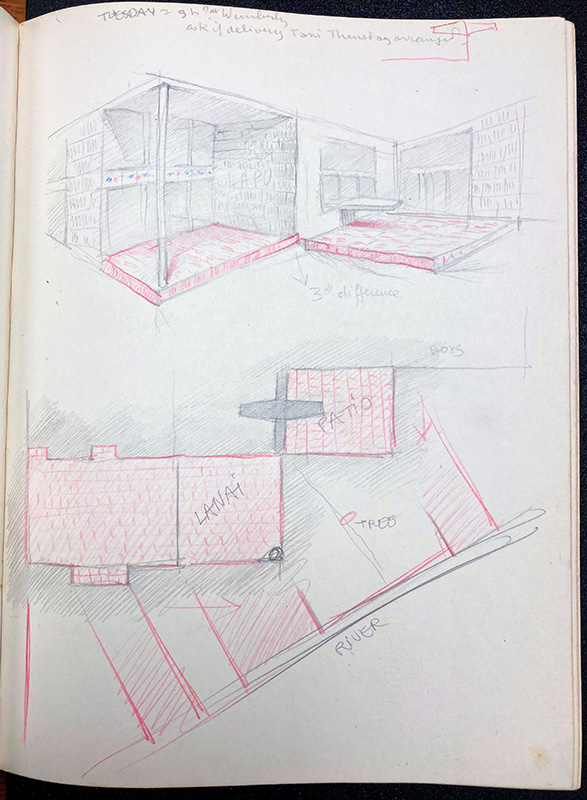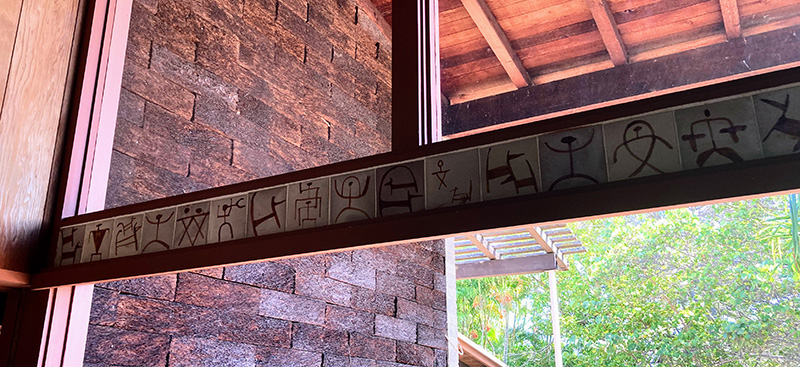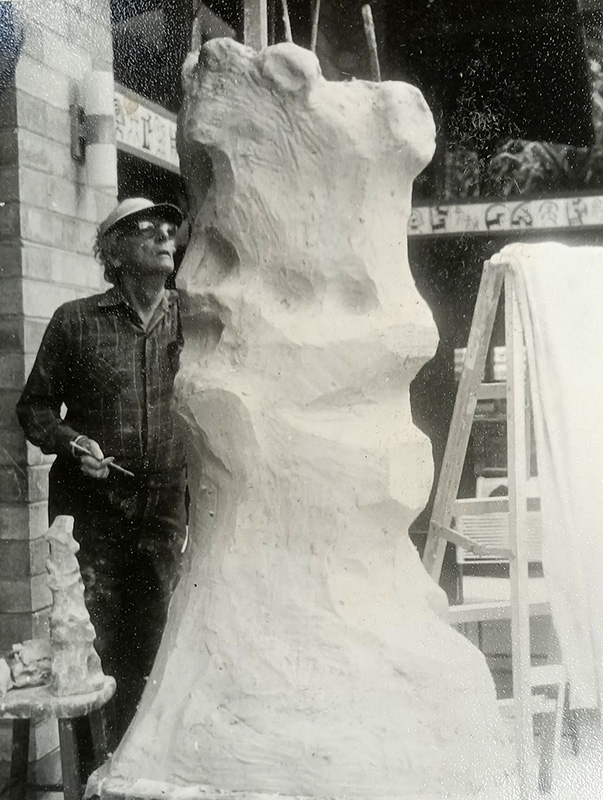Jean and Zohmah Charlot’s House: A Modernist Space Referencing Enduring Cultural Traditions
by Olivia Armandroff
Located in Honolulu’s Kāhala neighborhood, in close proximity to the shoreline, Jean and Zohmah Charlot’s house has a modest footprint and understated design that speak to a different era—the 1950s—when it was among the first houses to be built in an area that has become increasingly exclusive.
Embracing the opportunities afforded by its tropical location, the house has fluid transitions between indoor and outdoor spaces. At the entrance on the eastern side of the house, yellow, blue, and green glass windows (figure 1) are richly textured to simulate natural features such as the nearby ocean. Westward-facing windowed walls open onto lānais (patios), the garden, and the Wai‘alae Stream. In a clever design, the dining room table illustrates a triumph over structural boundaries, its top crossing through a sliding window from the interior dining room to the patio beyond.
My visit to the site, supported by a Decorative Arts Trust Research Grant, elucidated Charlot’s wider artistic practice. Charlot shaped the space as an artist, creating site-specific installations throughout the house, and as a collector, hanging pieces offered to him by friends and colleagues such as Josef Albers and Max Ernst. He also played an active role in conceiving its architectural design. As a muralist, Charlot had a close relationship with local modernist architects—including George “Pete” Wimberly, Vladimir Ossipoff, and Alfred Preis—who collaborated with him on the art for their newly finished buildings. Charlot’s fluency in architectural practices is evidenced by sketches, notes, floorplans, and three-dimensional, scale drawings, which are a part of Charlot’s extensive archival collection at the University of Hawai‘i at Mānoa.1 These drawings illustrate his experimental creative process as he worked through alternative layouts and decorative schemes for the house (figure 2).
Before settling in Hawai‘i in 1949—which he called home until his death 30 years later—Charlot’s travels brought him to many places, from his birthplace of Paris, to Mexico (where he launched his career as a member of the Mexican Renaissance), then across the continental United States, including New York, Georgia, Iowa, Colorado, and California. The design for this house reflects Charlot’s life story, and certain elements held associative powers for him, including high ceilings reminiscent of his childhood home in France and concrete floors and white plaster walls that paid homage to Mexican architectural traditions. The house was so closely intertwined with Charlot and his family’s identity that his wife, Zohmah, adopted a line drawing of its rear façade as her letterhead for the rest of her life.
Among the global referents in the modernist space, many demonstrate Charlot’s deep appreciation for Native Hawaiian, or Kānaka Maoli, culture. Following his arrival in Hawai‘i, Charlot’s murals, prints, and other work took inspiration from Native myths and the local landscape, and he cultivated connections within a community that celebrated these rich traditions. Charlot learned the Hawaiian language, ‘Olelo Hawai‘i, and researched the history of the island chain, writing both scholarly essays as well as creative plays in response.2 As early as 1950, this education included visits to petroglyph sites on several Hawaiian islands—from Pu‘uhonua o Hānaunau on Hawai‘i Island to Nu‘uanu Valley on O‘ahu—where he made rubbings, oftentimes alongside his artist friends. These visits served as inspiration for azulejo tiles painted by Charlot with interpretations of Hawaiian petroglyph motifs (figure 3) that form friezes crowning several portals in the house. Before settling on the tile pattern, Charlot’s sketchbooks show several other decorative schemes he considered, including a more large-scale mural of petroglyph designs.
Charlot’s interest in petroglyphs did not end here. In 1962, Charlot painted representations of two Hawaiian petroglyph motifs as a backdrop for his play, Na‘auao. In one of Charlot’s sketchbooks, alongside his storyboards for the play and drawings of its props and backdrop, he appears to have conceived of a series of petroglyph-inspired sculptures for his backyard, suggesting the ways his home continued to evolve in consort with his other work. Gradually, the backyard transformed into a sculpture garden where Charlot’s work was set in conversation with that of his peers, including Satoru Abe, whose sculpture of a dynamic figure also recalls a Hawaiian petroglyph.
The garden became a workspace for Charlot in 1973 when he embarked upon his most ambitious project on the subject, In Praise of Petroglyphs. This sculpture for Moanalua Intermediate School and an accompanying portfolio of prints were intended to raise awareness about the petroglyphs in the neighboring Moanalua Valley at a time when they were endangered by a proposed freeway project. Archival photographs show Charlot in his backyard constructing a full-scale, clay model for the sculpture, working beside a smaller plaster model and the house’s petroglyph tiles (figure 4).
The petroglyph motif became a tool for Charlot and his contemporaries, who made claims about the island chain’s long-standing and enduring artistic traditions in the period shortly after Hawai‘i’s statehood. The motif’s omnipresence in the artist’s house suggests the important role it played in his imagination, both in 1957 when the house was first envisioned, and throughout the remainder of his career as he continued to live and work in the space.
- Although Zohmah Charlot willed the house to the University of Hawai‘i at Mānoa, it has recently been returned to the care of the family.
- For more information on Charlot’s plays, see John Charlot, “Jean Charlot’s Hawaiian-Language Plays,” Rongorongo Studies 8, no. 1 (1998): 3–24.
Olivia Armandroff is a PhD candidate in Art History at the University of Southern California.
A print version of this article was published in The Magazine of the Decorative Arts Trust, one of our most popular member benefits. Join today!




